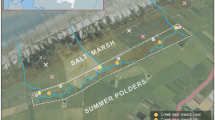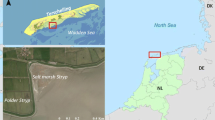Abstract
In 1986 a sluice gate barrier was completed in the mouth of the Oosterschelde estuary. The barrier has been partially or completely closed during 1986 and the first months of 1987. Consequently the high tides were reduced to such a level that the salt marshes were scarcely flooded. Since April 1987 the barrier has been closed on average during two out of 706 high tides a year. Although the barrier allows tidal exchange the tidal flow has been restricted as a result of the reduced width of the mouth of the estuary. This restriction of the tidal flow caused a 26 cm decrease of mean high water in the eastern part of the estuary. As a result the inundation frequencies of the salt marshes decreased.
The response of salt-marsh vegetation to this tidal reduction was analyzed using annual records (1982 till 1990) of species composition in 57 permanent plots in two marshes at the southern shore of the estuary. Analysis of the response of individual species to marsh elevation in the pre and the post-barrier situation revealed that most species moved down the marsh elevation gradient. The first axis of an ordination (DCA-1) was significantly negatively related to inundation frequency. Between 1984 and 1990 all plots were displaced towards a significantly higher ordination score, indicating a trend towards a species composition from higher up the marsh. The position of most plots along DCA-1 remained stable until 1985 and started to increase in 1986 or 1987. The vegetation in plots dominated either by Halimione portulacoides * or by Spartina anglica, started to change in 1985. This premature change was attributed to frost damage in January 1985. The initially high rate of change along DCA-1 decreased in 1989 and 1990. This would suggest that the vegetation re-equilibrated with the newly established tidal conditions. Further analysis revealed no significant difference in the relation between inundation frequency and sample score along DCA-1 between 1984 and 1990. This corroborates the view that species composition had re-equilibrated with the tidal conditions. Along DCA-2 the samples were displaced towards a significantly higher score as well. The change was attributed to an increase of the perennial Halimione and the annual Suaeda maritima. The annual Atriplex hastata displayed an increase from 1986 till 1988, but strongly declined in 1990. The transient response of this annual was described by DCA-3.
During the pre-barrier phase several attempts had been made to predict the vegetation response to tidal reduction. We developed a multivariate model (CCA) with inundation frequency as a constraining factor to describe the relation between inundation frequency and species composition in the pre-barrier phase in 1984. Next we used this model to predict the score of the samples along CCA-1 in the postbarrier phase from the inundation frequencies in 1990. The actual ordination score in 1990 was calculated from the observed species composition. The predicted ordination scores did not differ significantly from the observed ones. In retrospect it is concluded that the response of the vegetation to the reduction of the tides, as far as the fraction of species composition which is related to inundation frequency is concerned, could have been predicted by our model.
Access this chapter
Tax calculation will be finalised at checkout
Purchases are for personal use only
Preview
Unable to display preview. Download preview PDF.
Similar content being viewed by others
References
Adam, P., 1990. Saltmarsh ecology. Cambridge University Press, Cambridge, 461 pp.
Armstrong, W., E. J. Wright, S. Lythe & J. T. Gaynard, 1985. Plant zonation and the effects of the spring neap tidal cycle on soil aeration in a Humber salt marsh. J. Ecol. 73: 323–339.
Beeftink, W. G., 1965. Salt marsh communities of the SW Netherlands in relation to the European halophytic vegetation (In Dutch). PhD Thesis, Wageningen University, 167 pp.
Beeftink, W. G., M. C. Daane, W. de Munck & J. Nieuwenhuize, 1978. Aspects of population dynamics in Halimione portulacoides communities. Vegetatio 36: 31–43.
Beeftink, W. G., 1979. The structure of salt marsh communities in relation to environmental disturbances. In R. L. Jefferies & A. J. Davy (eds), Ecological processes in coastal environments. Blackwell, Oxford: 77–93.
Beeftink, W. G., 1987. Vegetation responses to changes in tidal inundation of salt marshes. In: J. van Andel, J. P. Bakker & R. W. Snaydon (eds), Disturbance in grasslands. Dr W. Junk Publishers, Dordrecht: 97–117.
Bertness, M. D. & A. M. Ellison, 1987. Determinants of pattern in a New England salt marsh plant community. Ecol. Monogr. 57: 129–147.
Chapman, V.J., 1974. Salt marshes and salt-deserts of the world. Cramer, Lehre, 2nd edn. 392 pp.
Cramer, W. & H. Hytteborn, 1987. The separation of fluctuation and long-term change in vegetation dynamics of a rising seashore. Vegetatio 69: 157–167.
De Jong, D. J., Z. de Jong & J. P. M. Mulder, 1993. Changes in area, geomorphology and sediment nature of salt marshes in the Oosterschelde (SW Netherlands) due to tidal changes. Hydrobiologia, in press.
De Jong, D. J. & T. J. de Kogel, 1985. Salt-marsh research with respect to the civil-engineering project in The Oosterschelde, The Netherlands. Vegetatio 62: 425–432.
De Kogel, T. J. & D. J. de Jong, 1980. Vegetatiekartering van de schorren in de Oosterschelde en het Krammer-Volkerak, 1978. Rijkswaterstaat, Dienst Getijdewateren. Nota DDMI-80.20.
De Leeuw, J., A. van den Dool, W. de Munck, J. Nieuwenhuize & W. G. Beeftink, 1991. Factors influencing the soil salinity regime along an intertidal gradient. Estuar. coast. Shelf Sci. 32: 87–97.
De Leeuw, J., L. P. Apon, P. M. J. Herman, W. de Munck & W. G. Beeftink, 1992. Vegetation response to experimental and natural disturbance in two salt-marsh plant communities in the south-west of the Netherlands. Neth. J. Sea Res. 30: 279–288.
Doing-Kraft, H. 1954. L’analyse des carrés permanents. Acta Bot. Neerl. 3: 421–425.
Ericson, L. & H. G. Wallentinus, 1979. Sea-shore vegetation around the Gulf of Bothnia. Wahlenbergia 5: 1–142.
Fresco, L. F. M., 1990. VEGROW: Processing of vegetation data. Shorthand manual V.4.0. S-BEES, Haren.
Groenendijk, A. M., 1986. Establishment of a Spartina anglica population on a tidal mudflat: a field experiment. J. Envir. Mg22: 1–12.
Groenendijk, A. M., J. G. J. Spieksma & M. A. Vink Lievaart, 1987. Growth and interactions of salt marsh species under different flooding regimes. In A. H. L. Huiskes, C. W. P. M. Blom & J. Rozema (eds), Vegetation between land and sea. Dr W. Junk Publishers, Dordrecht: 236–258.
Hill, M. O. & H. G. Gaugh, 1980. Detrended correspondence analysis, an improved ordination technique. Vegetatio 42: 47–58.
Huisman, J., H. OhT& L. F. M. Fresco, 1993. A hierarchical set of models for species response analysis. J. Veg. Sci. 4: 37–46.
Kamps, L. F., 1962. Mud distribution and land reclamation in the eastern Wadden shallows. Rijkswaterstaat Communication 4: 1–73.
Kooistra, M. J., 1978. Soil development in recent marine sediments of the intertidal zone in the Oosterschelde the Netherlands. Netherlands Soil Survey Institute, Wageningen. Soil Survey Papers 14: 1–183.
Long, S. P. & C. F. Mason, 1983. Saltmarsh ecology. Blackie, Glasgow, 160 pp.
Nienhuis, P. H. & A. C. Smaal, 1994. The Oosterschelde estuary, a case-study of a changing ecosystem: an introduction. Hydrobiologia 282/283: 1–14.
Oenema, O., 1990. Pyrite accumulation in salt marshes in the Eastern Scheldt, southwest Netherlands. Biogeochemistry 9: 75–98.
Olff, H., J. P. Bakker & L. F. M. Fresco, 1988. The effects of fluctuations in tidal inundation frequency on a salt marsh vegetation. Vegetatio 78: 13–19.
Rijkswaterstaat, 1978. Aanstaande veranderingen in de getijdebeweging op het Oosterschelde-bekken. Driemaandelijks Bericht Deltawerken 86: 284–290.
Rijkswaterstaat, 1989. Nieuwe randvoorwaarden voor het Oosterscheldesysteem. EOS-RVW rapportage, Middelburg.
Rozema, J., P. Bijwaard, G. Prast & R. Broekman, 1985. Ecophysiological adaptations of coastal halophytes from foredunes and salt marshes. Vegetatio 62: 499–521.
Saeijs, H. L. F. & J. P. Al, 1982. Environmental impact assessment for design and management of the Oosterschelde barrier. In: H. L. F. Saeijs, Changing estuaries, PhD Thesis, University of Leiden: 279–320.
Smaal, A. C. & R. C. Boeije, 1991. Veiliggetij, de effecten van de waterbouwkundige werken op het getijmilieu van de Oosterschelde. Nota GWWS 91.088 DGW/Directie Zeeland, Middelburg, 132 pp. (in Dutch).
Smies, M. & A. H. L. Huiskes, 1981. Holland’s Eastern Scheldt Estuary barrier scheme: some ecological considerations. Ambio 10: 158–165.
Sokal, R. R. & F. J. Rohlf, 1981. Biometry. Freeman, New York, 859 pp.
Ter Braak, C. J. F., 1986. Canonical correspondence analysis: a new eigenvector technique for multivariate direct gradient analysis. Ecology 67: 1167–1179.
Tutin, T. G., V. H. Heywood, N. A. Burges, D. M. Moore, D. H. Valentine, S. M. Walters & D. A. Webb, 1964–1980. Flora Europaea. Cambridge University Press, Cambridge. 5 Volumes.
Van Diggelen, J., 1988. A comparative study on the ecophysiology of salt marsh halophytes. PhD Thesis, Free University, Amsterdam, 208 pp.
Van der Maarel, E., 1979. Transformation of cover-abundance values in phytosociology and its effects on community similarity. Vegetatio 39: 97–114.
Watson, I. & C. W. Finkl Jr., 1990. State of the art in stormsurge protection: the Netherlands Delta Project. J. coast. Res. 6: 739–764.
Author information
Authors and Affiliations
Editor information
Rights and permissions
Copyright information
© 1994 Springer Science+Business Media Dordrecht
About this chapter
Cite this chapter
de Leeuw, J., Apon, L.P., Herman, P.M.J., de Munck, W., Beeftink, W.G. (1994). The response of salt marsh vegetation to tidal reduction caused by the Oosterschelde storm-surge barrier. In: Nienhuis, P.H., Smaal, A.C. (eds) The Oosterschelde Estuary (The Netherlands): a Case-Study of a Changing Ecosystem. Developments in Hydrobiology, vol 97. Springer, Dordrecht. https://doi.org/10.1007/978-94-011-1174-4_25
Download citation
DOI: https://doi.org/10.1007/978-94-011-1174-4_25
Publisher Name: Springer, Dordrecht
Print ISBN: 978-94-010-4512-4
Online ISBN: 978-94-011-1174-4
eBook Packages: Springer Book Archive




